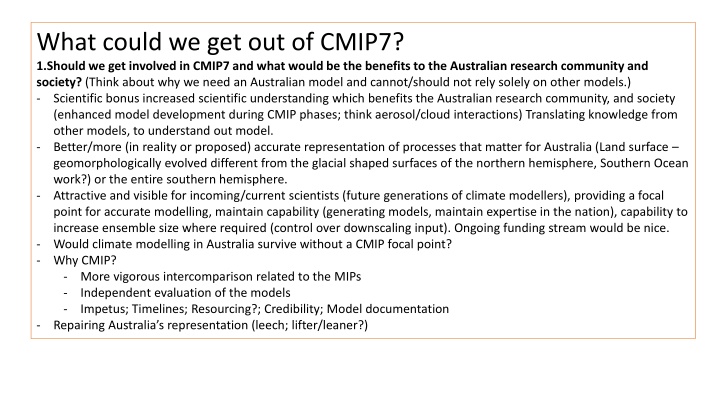
Benefits of Participating in CMIP7 for Australian Climate Research
Discover the advantages of Australia's involvement in CMIP7, including enhanced scientific understanding, improved model accuracy for regional processes, and the opportunity to shape future climate projections. Explore key science questions and potential outcomes, highlighting the relevance to Australia and the importance of an Australian model in climate research.
Download Presentation

Please find below an Image/Link to download the presentation.
The content on the website is provided AS IS for your information and personal use only. It may not be sold, licensed, or shared on other websites without obtaining consent from the author. If you encounter any issues during the download, it is possible that the publisher has removed the file from their server.
You are allowed to download the files provided on this website for personal or commercial use, subject to the condition that they are used lawfully. All files are the property of their respective owners.
The content on the website is provided AS IS for your information and personal use only. It may not be sold, licensed, or shared on other websites without obtaining consent from the author.
E N D
Presentation Transcript
What could we get out of CMIP7? 1.Should we get involved in CMIP7 and what would be the benefits to the Australian research community and society? (Think about why we need an Australian model and cannot/should not rely solely on other models.) - Scientific bonus increased scientific understanding which benefits the Australian research community, and society (enhanced model development during CMIP phases; think aerosol/cloud interactions) Translating knowledge from other models, to understand out model. - Better/more (in reality or proposed) accurate representation of processes that matter for Australia (Land surface geomorphologically evolved different from the glacial shaped surfaces of the northern hemisphere, Southern Ocean work?) or the entire southern hemisphere. - Attractive and visible for incoming/current scientists (future generations of climate modellers), providing a focal point for accurate modelling, maintain capability (generating models, maintain expertise in the nation), capability to increase ensemble size where required (control over downscaling input). Ongoing funding stream would be nice. - Would climate modelling in Australia survive without a CMIP focal point? - Why CMIP? - More vigorous intercomparison related to the MIPs - Independent evaluation of the models - Impetus; Timelines; Resourcing?; Credibility; Model documentation - Repairing Australia s representation (leech; lifter/leaner?)
What could we get out of CMIP7? 1.Should we get involved in CMIP7 and what would be the benefits to the Australian research community and society? (Think about why we need an Australian model and cannot/should not rely solely on other models.) - New generation of forcings for projections (cordex compliant would require CMIP7 forcing) -> - Links between ACCESS and BARPA (ACCESS based regional model), means no CMIP7 => limited BARPA downscaling - Benefits in understanding dynamics of downscaling when model inputs and regional model have the same physics. Ensemble member selection to focus on specific drought periods - Influence design of future CMIP. Proposals for extra MIPS/experimental design changes etc. of relevance. - International panel membership and influence CMIP task teams
What could we get out of CMIP7? 2.What are the key science questions we can address by participating in CMIP7 with an Australian model? For each science question consider: potential outcomes problems/issues that can be addressed relevance to Australia and the Australian community model features /components /processes that would be required to achieve this CORDEX 3 Regional projections of everything CMIP7! How stable is forest carbon sequestration to future climates? Interactions of vegetation and climate drought, extremes Fire models and dynamic vegetation into ESM version of CABLE Detection and Attribution What does climate change trend look like; How are extremes affected? Different forcing simulations. E.g. ozone hole affects SH more than NH Zonal gradient of projected warming across the Pacific. (Reducing ocean- mean state biases - double ITCZ, Indian Ocean) Teleconnections to Australian rainfall, links to SAM etc. Rain intensity, flood and drought. Will we be in El Nino-like state in future? Fix underestimation of surface winds and ocean damping. These oppose each other, and thus now get the right variability, but wrong. Ocean boundary layer? FAFMIP Stablisation experiments extremes and carbon budget under these scenarios How much carbon can we emit to stay within set limits. Carbon emissions promised and resultant temperature Policy relevance to any mitigation Active carbon cycle to ESM
What could we get out of CMIP7? 2.What are the key science questions we can address by participating in CMIP7 with an Australian model? For each science question consider: potential outcomes problems/issues that can be addressed relevance to Australia and the Australian community model features /components /processes that would be required to achieve this Net zero by 2050 what does this look like? Because ACCESS represents Australia s climate well Climate sensitivity Contribute to addressing the problem, but perhaps CMIP8 Cloud aerosol microphysics capability to support CMIP8; Ensemble selection e.g. one with drought We have control over our ensemble Case-study based work e.g. can downscale from specific features found in the large ensemble Scientific capacity to do stuff relevant to observed Large ensemble! Ozone location correction to readjust ozone as tropopause lifted, lift ozone up. Southern Ocean processes/Antarctica
